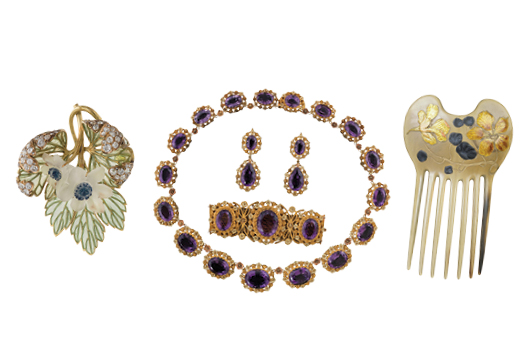
Jewelry has served as the ultimate in personal adornment
since ancient times, reflecting status and wealth as well as individual
aesthetics. Changes in fashion and societal norms, the clash of wars, and
economic ups and downs have all infused the vocabulary of jewelry designers.
That’s certainly apparent in a new exhibition at the Joslyn Art Museum in
Omaha, Nebraska, which traces the history of French jewelry from the 17th
century through the early 1950s.
“Bijoux Parisiens: French Jewelry from the Petit Palais,
Paris,” features approximately 70 pieces of jewelry and objets d’art, as well
as design drawings, fashion plates and photographs, showcasing the styles that
helped French makers set fashionable standards.
“Each piece of jewelry shown is a unique work of art,” says
Dana E. Cowen, Joslyn’s associate curator of European art. Those pieces reflect
“the patron’s particular values and interests, as well as the changing wealth
and social fabric of France at the time,” she explains.
Asked to single out examples of historically influenced
designs, she shares the backgrounds of several pieces, the origins of which
range from the Napoleonic era to World War II.
“When Napoleon Bonaparte crowned himself emperor in 1804, he
consciously linked his regime to cultures of the ancient past that recalled the
heroic and civic virtues of Greece and Rome,” Cowen relates, pointing to a gold
and enamel neoclassical necklace from around 1800 that features an enamel
medallion with a portrait of Athena suspended from two swans. Napoleon’s
fondness for cameos, she adds, created such high demand for this jewelry that
“jewelers began replicating the small carved hardstones in enamel.”
The French monarchy returned after the defeat of Napoleon I
in 1815. However, the aristocracy’s diminished financial situation meant they
needed to find more “economically prudent” ways to create jewelry that alluded
to their former glory, Cowen explains. Instead of costly gems like diamonds,
courtiers chose colored stones such as amethyst and tourmaline. Prompted by
this demand, jewelers came up with stylish options.
One such item on exhibit is an amethyst parure, or jewelry
set, from between 1820 and 1830, which “uses a stretched and woven gold setting
to provide a luxurious effect at a reasonable price,” she says.
Jewelers like Henri Husson, who ran several workshops in
Paris, created pieces that artfully paid homage to classical and Renaissance
themes — such as the Renaissance-style frame of gold florets, diamond garlands
and emerald pendants adorning one Husson brooch from about 1800. “The frame
surrounds an enameled panel featuring an antique procession of women playing
instruments, and a cherub,” Cowen says.
In the 1900s, artists looked to nature for inspiration,
according to the associate curator. The new style, appropriately named Art
Nouveau (“new art”), did not copy objects directly; rather, “artists
reinterpreted natural forms like plant life and insects in abstract ways,” she
explains. “One of the masters of this style was René Lalique, whose designs
played with line, color and transparency.”
Lalique’s Wood Anemone pendant — circa 1900 — is in the
shape of a flower, with diamonds on its upper leaves mimicking dewdrops struck
by early morning sunlight.
During World War II, precious materials were scarce, so
jewelry makers had to find more economical ways to use gold, says Cowen. To
meet the challenge, they developed what became known as the “gas pipe”
necklace, “due to its shape, which employed identical, interlocking links to
form a hollow, yet flexible tube to which decorative pendants could be
attached.”
One example is a Boucheron necklace from between 1945 and
1950. After the war, Cowen recounts, the jeweler wrapped it with an elegant
gold ribbon punctuated with diamonds.
In the exhibit, works of well-known artists such as Cartier,
Boucheron and Van Cleef & Arpels mingle with exemplary pieces by
less-widely known names such as Lucien Falize, Eugène Fontenay and Georges
Fouquet. It was their combined skills that helped forge new paths in the
history of jewelry design.
“The development of French jewelry design and creation,”
Cowen sums up, is “a mix of tradition, craftsmanship, artistry, creativity and
innovation.” That legacy will no doubt continue in future generations of
designers.
Image (left to right): gold, diamond, pâ
te de verre and plique-â
-jour enamel Wood Anemone pendant by René
Lalique, c.1900; amethyst and gold parure, artist unknown, France, 1820-1830; horn, silver and enamel comb by René
Lalique, c.1897-1898Article from the Rapaport Magazine - August 2017. To subscribe click here.